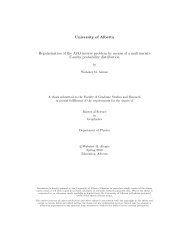Soner Bekleric Title of Thesis: Nonlinear Prediction via Volterra Ser
Soner Bekleric Title of Thesis: Nonlinear Prediction via Volterra Ser
Soner Bekleric Title of Thesis: Nonlinear Prediction via Volterra Ser
You also want an ePaper? Increase the reach of your titles
YUMPU automatically turns print PDFs into web optimized ePapers that Google loves.
4.5. SYNTHETIC AND REAL DATA EXAMPLES 70<br />
predicted with quadratic and cubic nonlinear terms. Figure 4.17(b) is the prediction<br />
using a third-order <strong>Volterra</strong> series with p = 7, q = 7, and r = 7. In Figure 4.17(c)<br />
I portray the part <strong>of</strong> the prediction attributed to the linear kernel (p = 7). Figures<br />
4.17(d) and 4.17(e) show the parts <strong>of</strong> the prediction associated with quadratic<br />
(q = 7) and cubic (r = 7) terms in the third-order <strong>Volterra</strong> series. In addition,<br />
Figure 4.17(f) illustrates the part <strong>of</strong> the prediction associated to both quadratic<br />
and cubic terms (q = 7 and r = 7). These terms give good predictions, especially<br />
for the apexes <strong>of</strong> events where linear terms cannot predict the data.<br />
Finally, I test the performance <strong>of</strong> the <strong>Volterra</strong> series with a marine data set. The<br />
data consist <strong>of</strong> 60 traces extracted from a marine common <strong>of</strong>fset section acquired<br />
over a salt body in the Gulf <strong>of</strong> Mexico (Figures 4.18(a) and 4.19(a)). The real data<br />
set has a combination <strong>of</strong> diffractions, roughly linear events, and hyperbolic events.<br />
I used filters with order p = 9, q = 9, and r = 9 for a third-order <strong>Volterra</strong> prediction<br />
(Figures 4.18(b) and 4.19(b)). In this case the data is properly modeled. I also<br />
compute the linear prediction filter with parameter p = 9 and attempt to model<br />
the data (Figure 4.18(d)). The prediction error between the original data and the<br />
prediction with a third-order <strong>Volterra</strong> series is small (Figure 4.18(c)), whereas the<br />
difference between the original data and the predicted data <strong>via</strong> a linear prediction<br />
method is large. In particular, the diffractions are leaking to the error panel as<br />
a consequence <strong>of</strong> improper modeling (Figure 4.18(e)). It is clear that the linear<br />
prediction was not able to properly model the data.<br />
In Figures 4.19(c), 4.19(d) and 4.19(e) I examine the individual contributions<br />
<strong>of</strong> the linear and nonlinear parts <strong>of</strong> the <strong>Volterra</strong> series to the prediction. Linear<br />
terms mostly predict linear moveouts with parameter p = 9; nonlinear terms model









